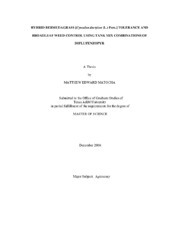| dc.description.abstract | Field studies were conducted during the 2003 and 2004 growing seasons to: 1)
evaluate the control of silverleaf nightshade and western ragweed, and (2) assess the
forage tolerance of Coastal and Tifton 85 bermudagrass hybrids using tank mix
combinations of diflufenzopyr. Herbicides that were evaluated in each study included
picloram, multiple rates of picloram with diflufenzopyr, triclopyr, triclopyr with
diflufenzopyr, dicamba + diflufenzopyr, and diflufenzopyr alone. Visual ratings were
taken on the weed control experiments approximately 30, 60 and 90 days after treatment.
Phytotoxicity ratings were taken prior to each harvest of the Coastal and Tifton 85
varieties to determine influence of each herbicide treatment. Each bermudagrass variety
was harvested twice during each growing season to determine dry matter yield and
quality. Forage quality, including crude protein, acid detergent fiber, and neutral
detergent fiber, was assessed using near infrared reflectance spectroscopy.
Adding diflufenzopyr to triclopyr did not consistently increase control of
silverleaf nightshade or western ragweed. In general, picloram + diflufenzopyr and
picloram applied alone provided the greatest control of both species at the highest rate of
picloram. Increased efficacy was more evident from the addition of diflufenzopyr to picloram in 2004 on western ragweed. By the final ratings in both experimental years,
dicamba + diflufenzopyr provided no more than 76% control of either species.
Both forage varieties showed significant variability in phytotoxicity between
years. Although observed levels of growth reduction were relatively high at the first
harvest in 2003, no treatment exceeded a 10% growth reduction by the second harvest
for either forage variety. In addition, the only significant reduction in dry matter yield
occurred at the first harvest of Coastal in 2003 from picloram + diflufenzopyr applied at
the highest rate. | en |


